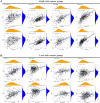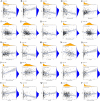The prognostic value and immunological role of CD44 in pan-cancer study
- PMID: 37117249
- PMCID: PMC10147611
- DOI: 10.1038/s41598-023-34154-3
The prognostic value and immunological role of CD44 in pan-cancer study
Abstract
To investigate the correlation between cluster of differentiation-44 (CD44) expression and immunotherapy response and identify its possible predictive value in pan-cancer. Datasets of 33 cancer types from The Cancer Genome Atlas (TCGA) database were applied to investigate the relationship of CD44 expression with prognosis, tumor mutational burden (TMB), and microsatellite instability (MSI), and determine its potential prognostic value in pan-cancer. Patients were split into high-risk and low-risk cancer groups based on the survival outcomes of various cancer types. Additionally, the underlying mechanisms of CD44 in the tumor microenvironment (TME) were analyzed using ESTIMATE and CIBERSORT algorithms and Gene Set Enrichment Analysis (GSEA). Subsequently, the biological role of CD44 at single-cell level was investigated using CancerSEA database. Variable expression levels of CD44 between tumor and adjacent normal tissues were identified in pan-cancer datasets, further survival analysis revealed that CD44 expression was associated with multiple clinical annotations and survival indicators. Besides, the expression of CD44 was significantly associated with TMB and MSI in 10 types and 6 types of cancer, respectively, indicating it could be exploited as a potential biomarker predicting immunotherapy outcomes. Meanwhile, CD44 could influence several crucial immune cell-related pathways. and the results revealed by CancerSEA database denoted the correlation of CD44 with malignant phenotype and functional states, further indicating it can serve as a potential therapeutic target in cancer management. Our study demonstrated that CD44 shows great promise as a prognostic biomarker in numerous cancers, which will assist in developing new strategies in cancer management.
© 2023. The Author(s).
Conflict of interest statement
The authors declare no competing interests.
Figures







Similar articles
-
KCNN4 is a Potential Biomarker for Predicting Cancer Prognosis and an Essential Molecule that Remodels Various Components in the Tumor Microenvironment: A Pan-Cancer Study.Front Mol Biosci. 2022 Jun 3;9:812815. doi: 10.3389/fmolb.2022.812815. eCollection 2022. Front Mol Biosci. 2022. PMID: 35720112 Free PMC article.
-
RecQ mediated genome instability 2 (RMI2): a potential prognostic and immunological biomarker for pan-cancers.Aging (Albany NY). 2022 May 12;14(9):4107-4136. doi: 10.18632/aging.204076. Epub 2022 May 12. Aging (Albany NY). 2022. PMID: 35552266 Free PMC article.
-
Pan-cancer analysis identifies RNF43 as a prognostic, therapeutic and immunological biomarker.Eur J Med Res. 2023 Oct 17;28(1):438. doi: 10.1186/s40001-023-01383-1. Eur J Med Res. 2023. PMID: 37848933 Free PMC article.
-
Pan-cancer analysis of the prognostic and immunological role of GJB2: a potential target for survival and immunotherapy.Front Oncol. 2023 Jun 23;13:1110207. doi: 10.3389/fonc.2023.1110207. eCollection 2023. Front Oncol. 2023. PMID: 37427102 Free PMC article. Review.
-
A Pan-Cancer Analysis Reveals the Prognostic and Immunotherapeutic Value of Stanniocalcin-2 (STC2).Front Genet. 2022 Jul 22;13:927046. doi: 10.3389/fgene.2022.927046. eCollection 2022. Front Genet. 2022. PMID: 35937984 Free PMC article. Review.
Cited by
-
CD44: A New Prognostic Marker in Colorectal Cancer?Cancers (Basel). 2024 Apr 19;16(8):1569. doi: 10.3390/cancers16081569. Cancers (Basel). 2024. PMID: 38672650 Free PMC article. Review.
-
CD44 in Bladder Cancer.Cancers (Basel). 2024 Mar 18;16(6):1195. doi: 10.3390/cancers16061195. Cancers (Basel). 2024. PMID: 38539529 Free PMC article. Review.
-
Extracellular Matrix as a Target in Melanoma Therapy: From Hypothesis to Clinical Trials.Cells. 2024 Nov 19;13(22):1917. doi: 10.3390/cells13221917. Cells. 2024. PMID: 39594665 Free PMC article. Review.
-
A paclitaxel-hyaluronan conjugate (ONCOFID-P-B™) in patients with BCG-unresponsive carcinoma in situ of the bladder: a dynamic assessment of the tumor microenvironment.J Exp Clin Cancer Res. 2024 Apr 10;43(1):109. doi: 10.1186/s13046-024-03028-5. J Exp Clin Cancer Res. 2024. PMID: 38600583 Free PMC article. Clinical Trial.
-
Potentiating anti-tumor immunity by re-engaging immune synapse molecules.Cell Rep Med. 2025 Mar 18;6(3):101975. doi: 10.1016/j.xcrm.2025.101975. Epub 2025 Feb 24. Cell Rep Med. 2025. PMID: 39999838 Free PMC article.
References
-
- Fitzmaurice C, et al. Global, regional, and national cancer incidence, mortality, years of life lost, years lived with disability, and disability-adjusted life-years for 29 cancer groups, 1990 to 2017: A systematic analysis for the global burden of disease study. JAMA Oncol. 2019;5:1749–1768. doi: 10.1001/jamaoncol.2019.2996. - DOI - PMC - PubMed
MeSH terms
Substances
LinkOut - more resources
Full Text Sources
Medical
Miscellaneous

